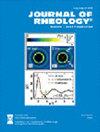丁基橡胶作为宏观交联剂在制备形状记忆自愈聚合物中的应用
IF 3.2
2区 工程技术
Q2 MECHANICS
引用次数: 0
摘要
最近,一种基于丁基橡胶(IIR)和聚丙烯酸十八烷基酯(PC18A)制备互连互穿聚合物网络(ipn)的简单策略被开发出来。常温下,丙烯酸十八烷基酯(C18A)单体在IIR熔体中进行无溶剂紫外聚合,得到了具有自愈和形状记忆功能的ipn。在这里,我们证明了用丙烯酸、甲基丙烯酸和10-十一烯酸接枝的IIR代替未改性的IIR,可以显著改善ipn的力学性能。差示扫描量热法、小角度x射线散射和广角x射线散射分析表明,PC18A的C18侧链并排排列形成片层状晶体,熔化温度Tm在46 ~ 52℃之间。透射电镜分析表明,在连续互穿的橡胶- pc18a基体中存在由晶域组成的准球形纳米颗粒。这种微观结构使其具有加热诱导的完全自恢复行为和有效的形状记忆功能。与由天然IIR制备的ipn相比,ipn的化学交联密度高出约10倍,这反映了垂坠乙烯基对IIR和PC18A组分之间共价互连程度的影响。接枝单体的类型显著影响ipn的力学性能,这可以用化学和物理交联对总交联密度的个别贡献来解释。IPN中接枝橡胶的量可进一步增加到80 wt。通过将甲苯掺入反应体系,产生具有广泛可调热性能和机械性能的ipn。本文章由计算机程序翻译,如有差异,请以英文原文为准。
Butyl rubber as a macro-cross-linker in the preparation of a shape-memory and self-healing polymer
Recently, a simple strategy was developed for preparing interconnected interpenetrating polymer networks (IPNs) based on butyl rubber (IIR) and poly(n-octadecyl acrylate) (PC18A). Solvent-free UV polymerization of n-octadecyl acrylate (C18A) monomer in the melt of IIR at ambient temperature resulted in IPNs with self-healing and shape-memory functions. Here, we demonstrate that the use of IIR grafted with acrylic acid, methacrylic acid, and 10-undecenoic acid instead of unmodified IIR provides a significant improvement in the mechanical properties of IPNs. Differential scanning calorimetry, small-angle x-ray scattering, and wide-angle x-ray scattering analysis reveal side-by-side packing of C18 side chains of PC18A to form lamellar crystals with a melting temperature Tm between 46 and 52 °C. Transmission electron microscopy analysis indicates the existence of quasispherical nanoparticles composed of crystalline domains, which are dispersed in a continuous interpenetrating rubber-PC18A matrix. This microstructure provides them a complete self-recovery behavior induced by heating and an efficient shape-memory function. IPNs exhibit around tenfold higher chemical cross-link density as compared to those prepared from the native IIR, reflecting the effect of pendant vinyl groups on the extent of covalent interconnections between the IIR and PC18A components. The type of the grafted monomers significantly affects the mechanical performance of IPNs, which can be explained with the individual contributions of chemical and physical cross-links to the total cross-link density. The amount of the grafted rubbers in IPN could be further increased up to 80 wt. % by the incorporation of toluene into the reaction system, resulting in IPNs with a wide range of tunable thermal and mechanical properties.
求助全文
通过发布文献求助,成功后即可免费获取论文全文。
去求助
来源期刊

Journal of Rheology
物理-力学
CiteScore
6.60
自引率
12.10%
发文量
100
审稿时长
1 months
期刊介绍:
The Journal of Rheology, formerly the Transactions of The Society of Rheology, is published six times per year by The Society of Rheology, a member society of the American Institute of Physics, through AIP Publishing. It provides in-depth interdisciplinary coverage of theoretical and experimental issues drawn from industry and academia. The Journal of Rheology is published for professionals and students in chemistry, physics, engineering, material science, and mathematics.
 求助内容:
求助内容: 应助结果提醒方式:
应助结果提醒方式:


